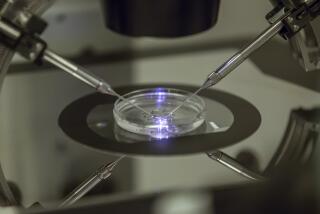Some fertility treatments linked to higher risk of birth defects
- Share via
For couples seeking to overcome infertility by turning to assisted reproductive technology – which can be invasive and expensive – an increased risk of birth defects probably won’t stand in their way. Still, a study released Saturday by the New England Journal of Medicine may give some prospective parents a little something to think about as they mull their options for fertility treatment.
The study is based on data from more than 300,000 births in the state of South Australia (population 1.6 million) between 1986 and 2002, including 6,163 that came about with the help of some form of assisted reproductive technology (ART). When any of the babies was identified as having a birth defect before age 5, doctors made a report to a state registry and the information was included in the analysis.
The researchers found that 8.3% of the children whose conception was helped along by doctors developed a birth defect, compared with 5.8% of the children who were conceived naturally and spontaneously. After adjusting for demographic and other factors that could influence the calculations, the researchers found that using ART was associated with a 28% increased risk of having a baby with a birth defect. The types of defects included “cardiovascular, musculoskeletal, urogenital, and gastrointestinal abnormalities and cerebral palsy,” they reported.
Next, the team assessed the risk of individual types of ART, starting with in vitro fertilization. IVF involves putting an egg and a sperm in a laboratory dish, where they combine and grow for several days before being transferred to a woman’s uterus. Though the raw data indicated that IVF was linked with a 26% increased risk in birth defects, after statistical adjustments the increase was no longer significant (that is, the difference could have been due to random chance).
The story was different for another ART technique called intracytoplasmic sperm injection, or ICSI. It involves injecting a single sperm into an egg, and is often used to overcome male factor infertility. Babies born this way had a 57% increased risk of developing a birth defect compared with babies born to fertile women, even after accounting for demographic and other influential factors.
What’s more, the researchers calculated that the increased risk rose to 66% in cases where fresh embryos were used. When frozen embryos were used, the risk of birth defects was not significantly higher than for fertile women, the researchers found. They speculated that the process of freezing and then thawing the embryos might weed out those that are naturally prone to developing a birth defect, among other theories.
The researchers said there are “biologically plausible” reasons why ICSI would increase the risk of birth defects, though this study doesn’t show that the treatment actually caused the birth defects that were reported. The investigators added that the type of male infertility that leads couples to use ICSI could also be responsible for the increase in birth defects all by itself.
Intrauterine insemination, gamete intrafallopian transfer and use of the drug clomiphene citrate (better known as Clomid) at home also were linked with an increased risk of birth defects, though the number of such cases was relatively small.
Interestingly, the researchers found that women who had previously tried some type of ART (but had not gotten pregnant) and then went on to get pregnant on their own were 25% more likely to have a baby with a birth defect compared with women with no history of infertility. In addition, women with a history of infertility – but who never tried a kind of ART – who then got pregnant on their own were 29% more likely to give birth to a baby with a birth defect.
Those findings may sound strange, but they’re in line with another study of Danish births. The researchers said this can probably be traced (in part) to women using Clomid on their own, outside of fertility clinic care.
The women who opted for fertility treatment were more likely than their fertile counterparts to be older, white, childless and to have a higher income. They were also more likely to deliver their babies early (at less than 37 weeks and at less than 32 weeks) and to require aC-section.
The researchers emphasized that “the large majority of births resulting from assisted conception were free of birth defects.” Still, they concluded, “our findings can help provide guidance in counseling patients who are considering treatment for infertlity.”
Dr. Joe Leigh Simpson, president-elect of the International Federation of Fertility, responded to the study in a prepared statement:
“This study largely confirms what we already know, that there is a slightly increased risk of problems in children conceived via assisted conception. We suspect that a large part of this may be due to the nature of infertility itself – if someone has a fertility problem in the first place, then it wouldn’t be surprising if there is an increased frequency of problems in their offspring, such as birth defects, even after achieving pregnancy.”
Return to the Booster Shots blog.






